GIVA Elevating Conversions Through Personalized Shopping Journeys with CustomFit.ai
GIVA, a fast-growing jewelry brand, partnered with CustomFit.ai to transform its online shopping experience with personalization at scale. By testing multiple variations across product discovery, category visibility, checkout flow, and promotional nudges, GIVA unlocked significant improvements in engagement and conversions.
Brand Background
GIVA is a leading D2C jewelry brand, offering elegant silver and gold collections designed for everyday luxury. With a strong focus on customer delight, GIVA leverages technology and personalization to simplify buying journeys and increase sales velocity.
Experiment 1: Two-Row Category Display
Objective:
Improve product discovery and category clicks by showing more visible options upfront.
Methodology:
- Personalized Variant: Two visible rows of categories placed prominently on the homepage.
- Default Variant: A single row requiring users to scroll for more options.
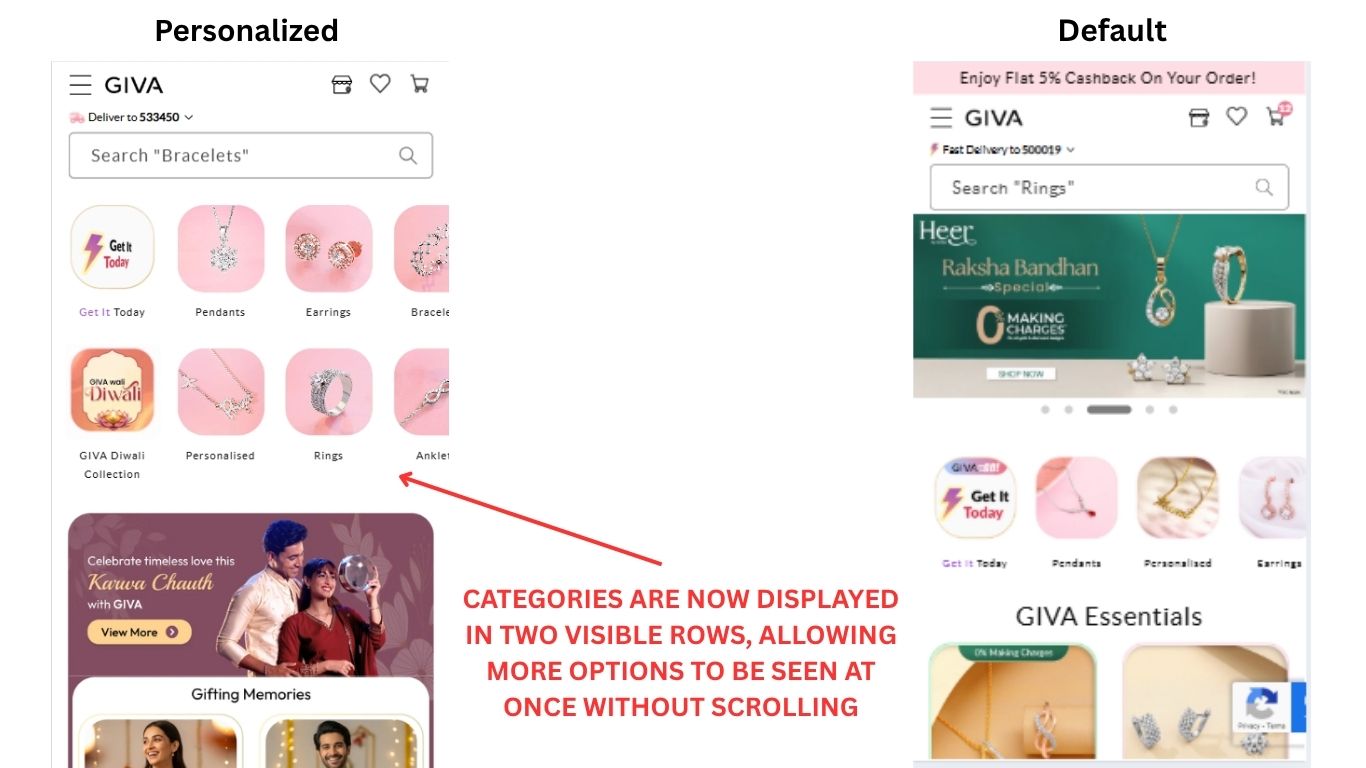
Results:
- Higher visibility of categories led to more clicks across product collections.
- Customers explored beyond top categories, improving cross-category discovery.
Insights:
Making categories instantly accessible reduces friction, encourages exploration, and sets the stage for higher conversions.
Experiment 2: Toaster for Add-to-Cart
Objective:
Streamline the cart experience and reduce friction after adding items.
Methodology:
- Personalized Variant: Replaced the popup modal with a toaster notification at the bottom, auto-closing after 3 seconds, while still offering “View Cart” and “Checkout Now.”
- Default Variant: Popup overlay interrupting the browsing experience.
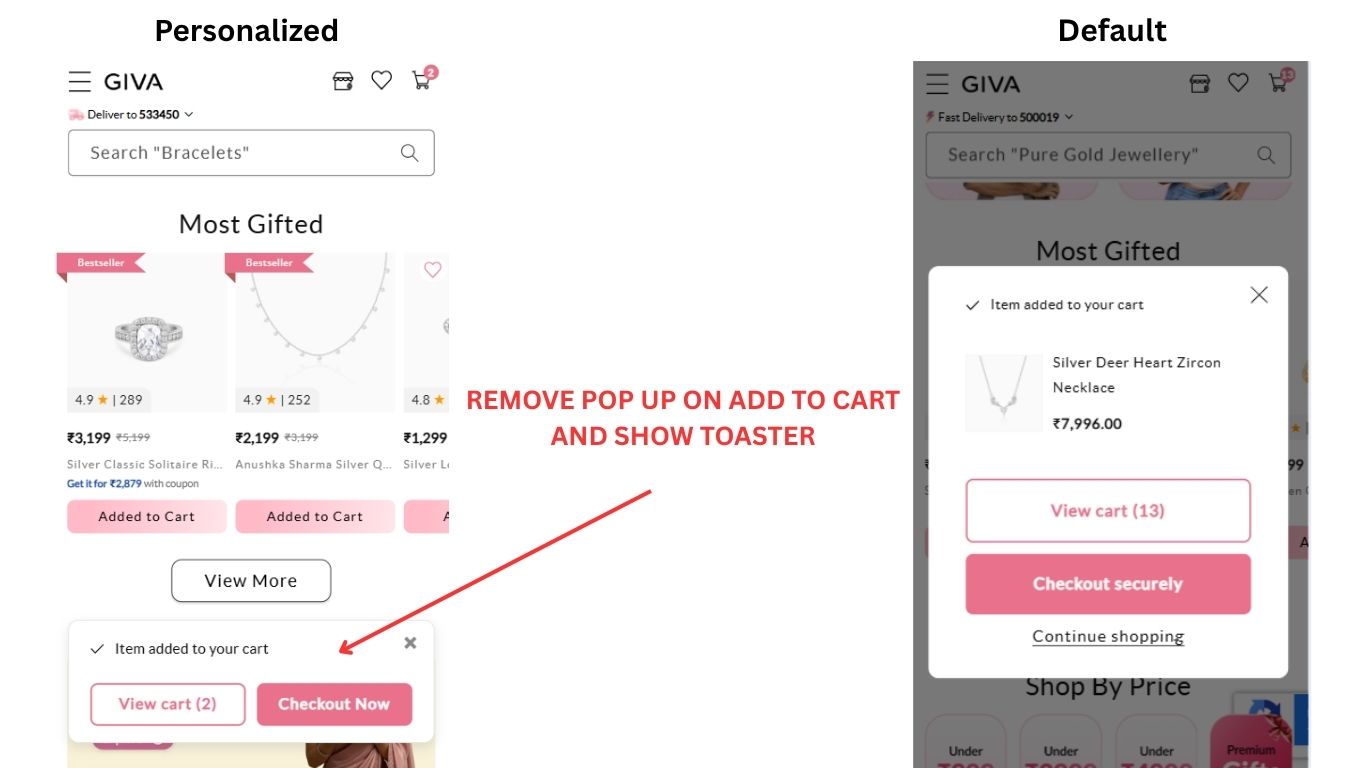
Results:
- Customers preferred the lightweight, non-intrusive experience.
- Improved continuation of browsing and faster checkout decisions.
Insights:
Minimizing interruptions creates smoother flows, keeping users engaged with the product catalog.
Experiment 3: PDP Variants — Model vs Mood
Objective:
Test which product display style resonates more with customers—lifestyle images with a model or clean, product-focused “mood” shots.
Methodology:
- Split traffic evenly between the Model Variant and the MoodMood Variant.

Results:
- Clear differences in engagement patterns:
- Model images boosted emotional connection and aspiration.
- Mood images gave clarity on product details.
- Model images boosted emotional connection and aspiration.
Mood vs Model vs Standard - 50% of the users will see the model image as the hero image and rest of them will see the mood image
Insights:
Different product categories may require different PDP approaches. Lifestyle imagery builds desire, while mood/product shots work best for detail-oriented shoppers.
Experiment 4: Nudges on Cart & Wishlist
Objective:
Increase conversions by re-engaging shoppers who had items in cart or wishlist.
Methodology:
- Cart Nudge: Personalized banner reminding users of treasures waiting in their cart.
- Wishlist Nudge: Gentle push for customers with saved items, encouraging checkout.
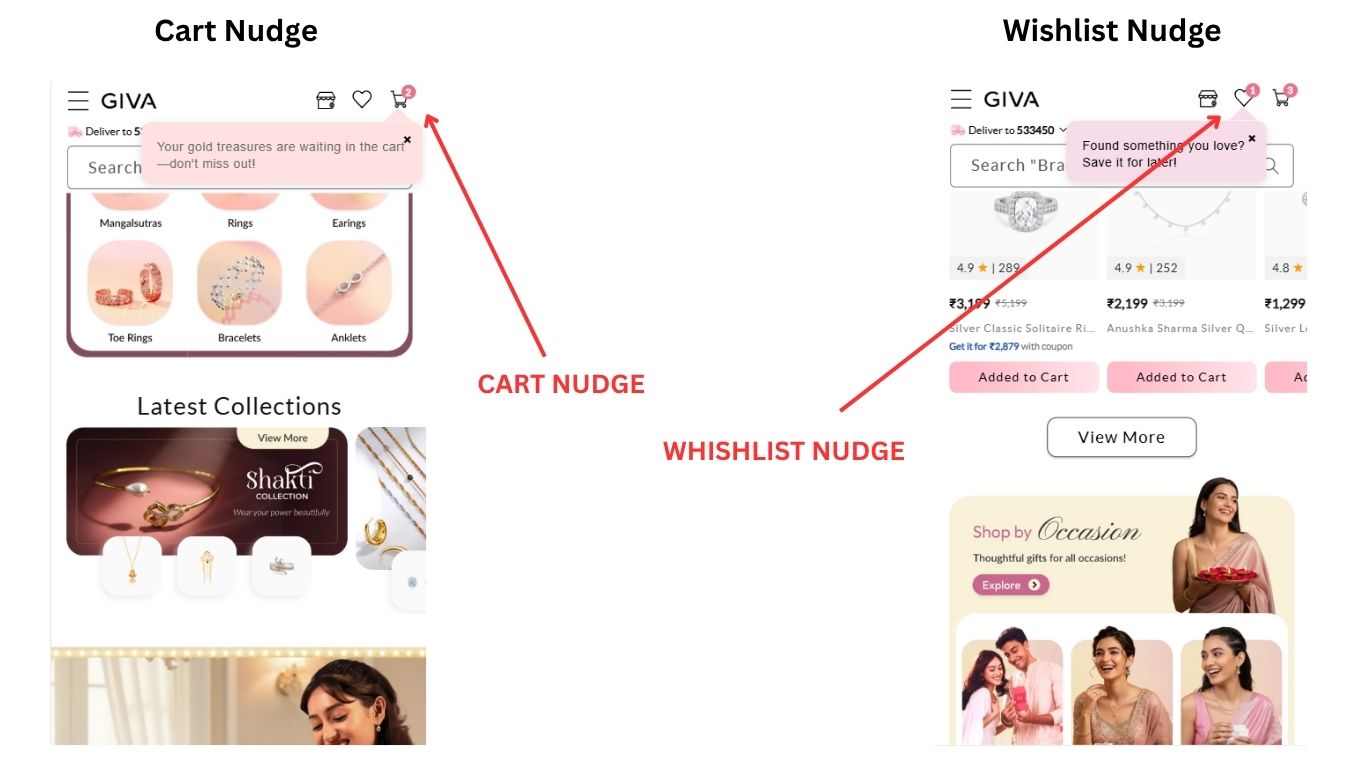
Results:
- Both nudges drove strong re-engagement and improved conversion rates.
- Cart nudges performed particularly well by reducing abandonment.
Insights:
Timely reminders, especially contextual ones, act as effective triggers without feeling pushy.
Experiment 5: Search-Driven Dynamic Banners
Objective:
Personalize discovery by aligning banners with user intent.
Methodology:
- Banners dynamically changed based on user’s search term (e.g., “Bracelets” → bracelet-related creative).
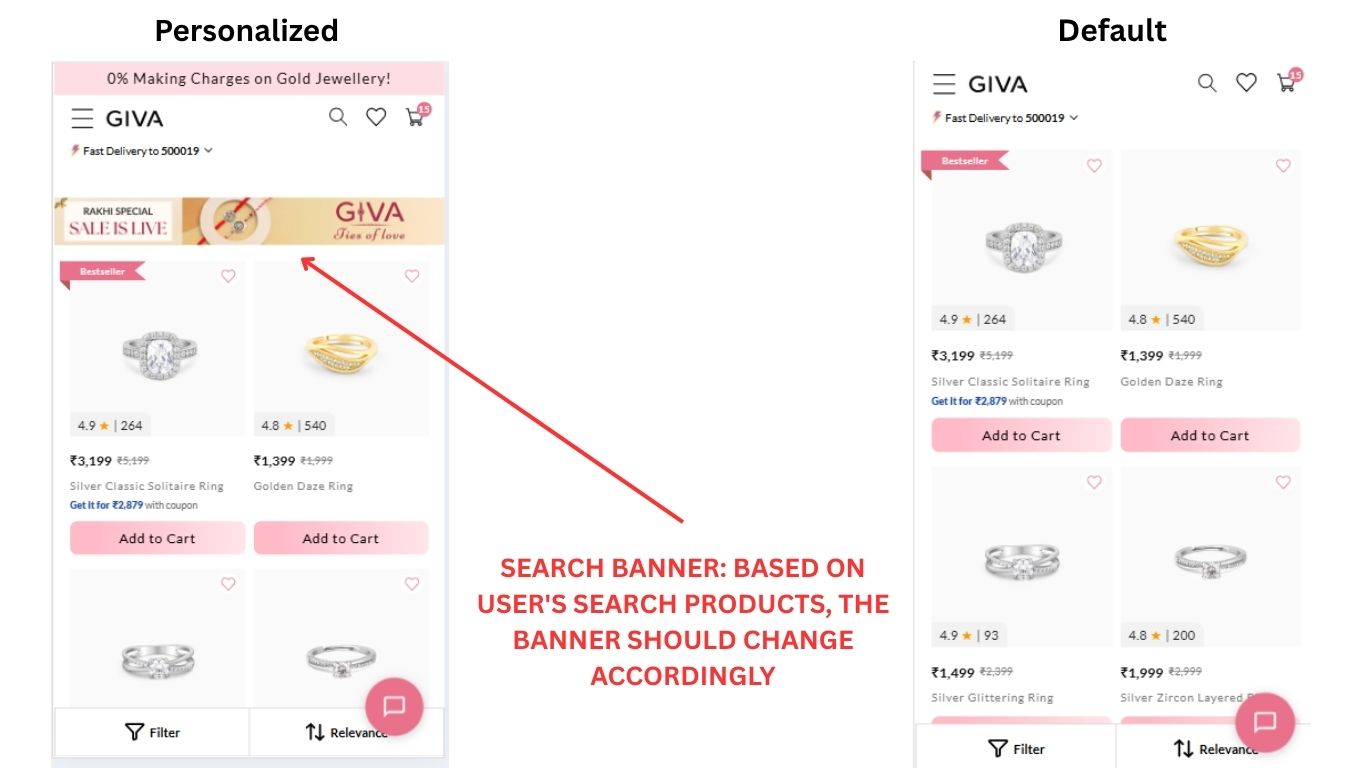
Results:
- Increased click-through on banners as users connected with relevant visuals.
- Improved product discovery and intent alignment.
Insights:
Dynamic personalization strengthens relevance and captures shopper attention at the right moment.
Experiment 6: Pincode-Based Same-Day Delivery
Objective:
Boost urgency and trust through delivery promise personalization.
Methodology:
- Before 1 PM: Banner and category displayed “Get it Today.”
- After 1 PM: Automatically switched to “Get it by Tomorrow.”
- Shown only to eligible pin codes.
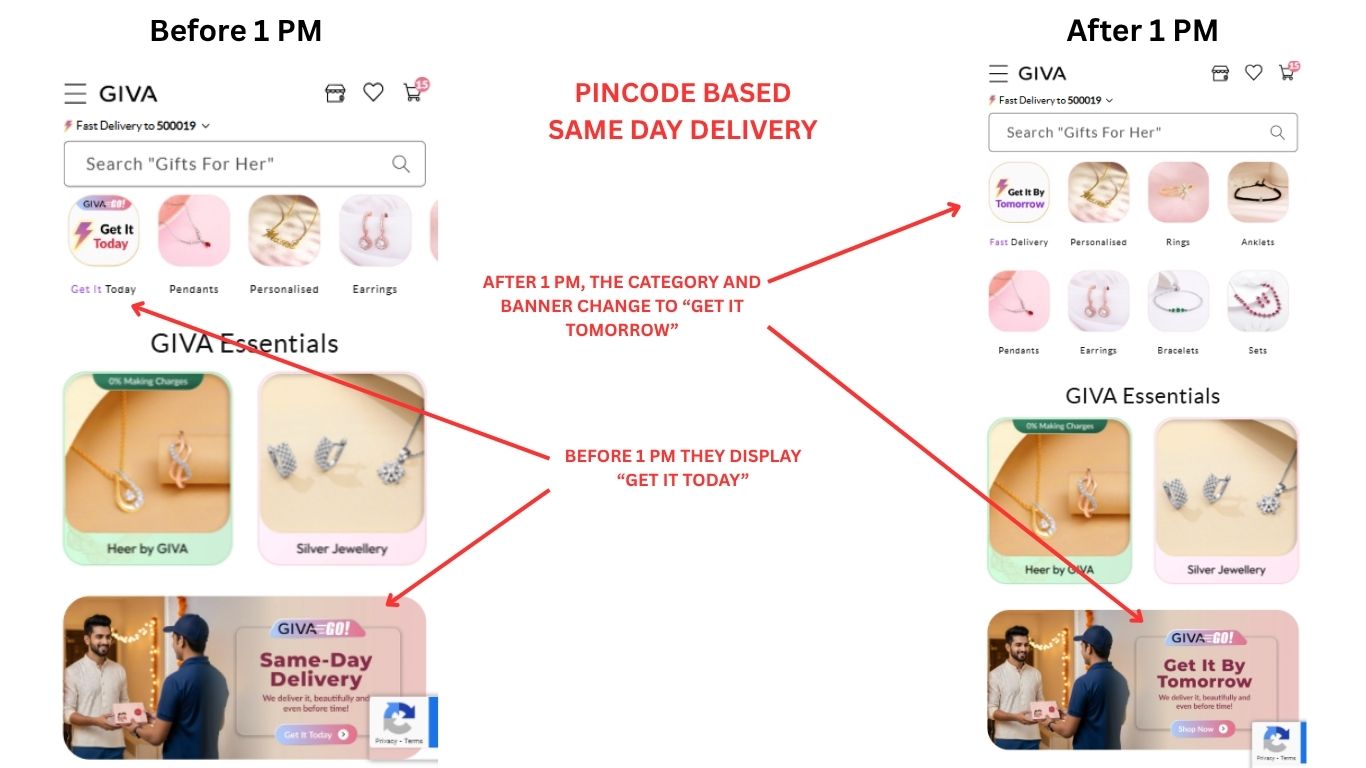
Results:
- Improved conversions in eligible cities where delivery speed influenced buying decisions.
- Shoppers responded strongly to same-day delivery assurance.
Insights:
Delivery-based personalization builds urgency and competitive advantage, especially in fast-moving gifting categories like jewelry.
Experiment 7: Shoppable Celebrity Reels
Objective:
Enhance product discovery and engagement by leveraging celebrity-driven video content and making it directly shoppable.
Methodology:
- Personalized Variant: Integrated video reels featuring celebrities wearing GIVA products. Each reel was made shoppable, allowing customers to add items to their cart directly from the video.
- Default Variant: Standard product listings and banners without interactive video content.

Results:
- The personalized variant drove significantly higher engagement rates, as shoppers interacted with video content more than static images.
- Customers showed greater intent to purchase when seeing products styled by celebrities, validating the influence of social proof in luxury and fashion categories.
- Shoppable reels bridged the gap between inspiration and action, reducing the steps required to purchase.
Insights:
- Video-first experiences are highly effective in jewelry and fashion e-commerce, where lifestyle appeal is critical.
- Making reels shoppable in real-time reduces drop-offs by enabling immediate product selection.
- Celebrity-driven content builds trust, aspiration, and brand authority, creating a stronger pull toward conversions.
Conclusion
Through a series of personalization experiments powered by CustomFit.ai, GIVA achieved tangible improvements in engagement and conversions:
- Category clicks increased with two-row display.
- Smoother checkout experience via toaster ATC flow.
- Higher emotional connect with PDP image testing.
- Re-engagement uplift through cart and wishlist nudges.
- Relevance-driven discovery using search-personalized banners.
- Urgency and trust boosts through pincode-based delivery messaging.
GIVA’s journey highlights how multi-layered personalization across the shopping funnel can significantly improve customer journeys and business outcomes. With actionable insights from each test, GIVA continues to refine its strategy to meet customer expectations and lead in the competitive D2C jewelry space.



.svg)

